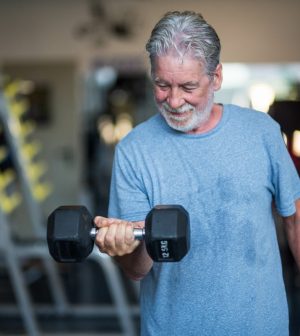- Skip Storing This Everyday Product in the Fridge Door
- Green Tea + B3 Pairing May Boost Brain Health
- Navigating Your Midlife Crisis: Embracing New Possibilities
- City Raccoons Showing Signs of Domestication
- Mapping the Exposome: Science Broadens Focus to Environmental Disease Triggers
- One Week Less on Social Media Linked to Better Mental Health
- Your Brain Changes in Stages as You Age, Study Finds
- Some Suicide Victims Show No Typical Warning Signs, Study Finds
- ByHeart Formula Faces Lawsuits After Babies Sickened With Botulism
- Switch to Vegan Diet Could Cut Your Greenhouse Gas Emissions in Half
Exercise at One Time of Day Might Be Best for Blood Sugar Control

Folks trying to control their blood sugar levels might do best to work out in the evening, a new study suggests.
Exercise performed between 6 p.m. and midnight appeared to be better at controlling blood sugar levels all day long, according to results published June 10 in the journal Obesity.
This was particularly true of people with the sort of impaired blood sugar regulation associated with diabetes, researchers said.
The results show that doctors “should consider the optimal timing of the day to enhance the effectiveness of the exercise and physical activity programs they prescribe,” said researcher Jonatan Ruiz, a professor of physical activity and health with the University of Granada in Spain.
For the study, researchers recruited 186 overweight and obese adults and tracked their activity and blood glucose levels for two weeks using wearable devices.
People were categorized based on when they accumulated more than 50% of each day’s moderate to vigorous physical activity – “morning” for 6 a.m. to noon, “afternoon” for noon to 6 p.m. and “evening” for 6 p.m. to midnight.
Some were categorized as “mixed” if no defined time window accounted for more than half their day’s exercise, and others were marked as “inactive” if they didn’t get any moderate to vigorous exercise.
Those who worked out in the evening were more likely to have lower daytime, nighttime and overall blood sugar levels, particularly if they had impaired glucose regulation, results show. The pattern was the same for both men and women.
“As the field moves towards individualized exercise prescriptions for different chronic conditions, this study now provides additional insights beyond just telling patients to ‘move more,’ but instead to move as often as possible and to prioritize afternoon-to-evening movement when feasible for glucose regulation,” Renee Rogers, a senior scientist of physical activity and weight management with the University of Kansas Medical Center, said in a journal news release. Rogers was not associated with the research.
More information
The American Diabetes Association has more about blood sugar and exercise.
SOURCE: The Obesity Society, news release, June 10, 2024
Source: HealthDay
Copyright © 2025 HealthDay. All rights reserved.










